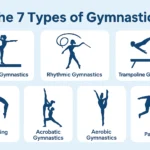At the Olympics, the all-around competition is a test of a gymnast’s skill across all apparatuses. It measures their performance in multiple disciplines, demanding high-level proficiency in a wide range of skills.
For women’s gymnastics, the all-around consists of:
- Vault
- Uneven Bars
- Balance Beam
- Floor Exercise
For men’s gymnastics, the all-around includes:
- Floor Exercise
- Pommel Horse
- Rings
- Vault
- Parallel Bars
- High Bar
In both the individual and team formats, gymnasts perform one routine on each apparatus, with the combined score from all events determining their final ranking.
The competition is based on a difficulty score (D-score) and an execution score (E-score), with deductions made for errors such as form breaks, steps, and balance issues. The gymnast with the highest cumulative score from all apparatuses wins the title.
Individual All-Around in Olympic Gymnastics
The individual all-around is perhaps the most coveted title in Olympic gymnastics. It is a true test of a gymnast’s overall ability, requiring excellence in multiple areas and the ability to perform under immense pressure.
Qualification
In the qualification round, gymnasts are scored on difficulty (D-score) and execution (E-score). The top 24 gymnasts from the qualification round, based on their total combined scores, advance to the final. However, only two gymnasts per country are allowed to participate in the final, ensuring that there is a broad international representation.
Finals
In the final, gymnasts perform again on each apparatus, but this time, only the top three scores from each gymnast’s performance count toward their final total. Gymnasts must bring their best performances across all events, as even a small mistake on one apparatus can affect the overall result.
The gymnasts with the highest combined score from all events are awarded the gold, silver, and bronze medals.
Example of an Individual All-Around in Olympic Gymnastics
Let’s imagine Emma, a gymnast competing in the Individual All-Around event at the Olympics. Here’s a breakdown of her journey:
1. Qualification Round
In the qualification round, Emma performs on all four apparatuses: vault, uneven bars, balance beam, and floor exercise. For each routine, Emma is scored on:
- Difficulty (D-score): How difficult the skills in her routine are.
- Execution (E-score): How well she performs the skills, with deductions for mistakes like wobbles or missed landings.
Emma’s total score from all four events is added together, and she ranks based on her combined score. The top 24 gymnasts from all countries advance to the final. However, only two gymnasts per country can make it to the final. Emma qualifies in 14th place, and she’s excited to compete again in the final!
2. Finals Round
In the final, Emma must perform once again on all four apparatuses. However, this time, only her best three scores count toward her total score. For example:
- Vault: Emma scores 15.0 (good vault, strong landing)
- Uneven Bars: She scores 14.7 (a small mistake on her dismount)
- Balance Beam: Emma scores 15.3 (excellent routine, no mistakes)
- Floor Exercise: Emma scores 15.5 (her best performance of the day)
In the final, only her top three scores are counted, which are Vault (15.0), Balance Beam (15.3), and Floor Exercise (15.5). So, she adds those three scores together:
15.0 + 15.3 + 15.5 = 45.8
At the end of the final, the gymnast with the highest combined score wins the gold medal, the second-highest wins silver, and the third-highest wins bronze. Emma finishes with a total score of 45.8, and she wins the silver medal.
The Team All-Around in Olympic Gymnastics
The Team All-Around competition in Olympic gymnastics is a key event where gymnasts from different countries perform as a team rather than as individuals. It is a unique aspect of the sport because it combines the individual skills of each gymnast with the need for teamwork and consistency.
Qualification for the Team All-Around
Each team consists of four gymnasts for the women’s competition and six gymnasts for the men’s competition. The gymnasts on the team must perform on all apparatuses, but only the top three scores from each apparatus are counted toward the team’s total score.
- Women’s Team: 4 gymnasts, with the top 3 scores from each apparatus counting.
This format is often referred to as “four up, three count”. It means that even if a gymnast makes a mistake on an apparatus, the team can still rely on the other gymnasts to help cover the error.
- Men’s Team: 6 gymnasts, with the top 3 scores from each apparatus counting.
This format is known as “three up, three count”, meaning that the top three gymnasts’ scores on each apparatus are considered for the team’s final total.
The Team Final
Once the top 8 teams qualify, they move on to the team final, where they compete in a more high-pressure environment. Each gymnast performs on all apparatuses, and only the top three scores from each apparatus count toward the team’s total score. This system is known as “three up, three count”.
A country’s coach will often decide which gymnast competes on which apparatus to maximize the team’s strengths and minimize weaknesses. For example, a gymnast who excels at vault may not perform on the balance beam, leaving the beam routine to someone stronger in that area.
Rotation Order
During the team final, gymnasts rotate through the apparatuses in a pre-determined rotation order, which is the same for all teams. This ensures fairness in the competition.
The rotation order for women’s gymnastics is:
- Vault
- Uneven Bars
- Balance Beam
- Floor Exercise
The rotation order for men’s gymnastics is:
- Floor Exercise
- Pommel Horse
- Rings
- Vault
- Parallel Bars
- High Bar
Example: The Team All-Around in Olympic Gymnastics
Let’s say the USA women’s team competes in the qualification and scores the following:
- Gymnast 1 scores 14.8 on Vault, 15.2 on Bars, 14.6 on Beam, 15.5 on Floor.
- Gymnast 2 scores 15.1 on Vault, 14.9 on Bars, 14.7 on Beam, 15.2 on Floor.
- Gymnast 3 scores 14.9 on Vault, 15.3 on Bars, 15.1 on Beam, 14.8 on Floor.
- Gymnast 4 scores 15.0 on Vault, 15.0 on Bars, 14.9 on Beam, 15.3 on Floor.
For each event, the team can drop the lowest score, so here’s how it would work:
- Vault: 15.0, 15.1, 14.9 → Top 3 scores count.
- Bars: 15.3, 15.2, 15.0 → Top 3 scores count.
- Beam: 15.1, 14.9, 14.6 → Top 3 scores count.
- Floor: 15.5, 15.3, 15.2 → Top 3 scores count.
Each event has the top 3 scores added up to create a total score for the team. The USA qualifies for the team final.
The Team Final
In the team final, the top 8 teams from the qualification round compete. The competition is high-pressure, and each gymnast performs on all apparatuses again. The top 3 scores from each apparatus count toward the team’s total.
Let’s say the USA women’s team competes in the final, and each gymnast performs again on all apparatuses, just like in the qualification round.
Rotation Order
The rotation order for the women’s team is as follows:
- Vault
- Uneven Bars
- Balance Beam
- Floor Exercise
Vault (Rotation 1)
- Gymnast 1: Scores 15.5 (Solid vault)
- Gymnast 2: Scores 14.8 (Small hop on landing)
- Gymnast 3: Scores 15.0 (Good vault)
- Gymnast 4: Scores 15.2 (Strong vault)
Top 3 Scores for Vault:
- Gymnast 1 (15.5)
- Gymnast 4 (15.2)
- Gymnast 3 (15.0)
Total for Vault: 45.7
Uneven Bars (Rotation 2)
- Gymnast 1: Scores 14.3 (Minor form deductions)
- Gymnast 2: Scores 15.4 (Clean routine)
- Gymnast 3: Scores 15.0 (Solid routine)
- Gymnast 4: Scores 14.9 (Minor mistake on dismount)
Top 3 Scores for Uneven Bars:
- Gymnast 2 (15.4)
- Gymnast 3 (15.0)
- Gymnast 4 (14.9)
Total for Uneven Bars: 45.3
Balance Beam (Rotation 3)
- Gymnast 1: Scores 14.6 (Small wobble)
- Gymnast 2: Scores 15.5 (Near-perfect routine)
- Gymnast 3: Scores 15.2 (Good balance, minor correction)
- Gymnast 4: Scores 15.1 (Strong routine)
Top 3 Scores for Balance Beam:
- Gymnast 2 (15.5)
- Gymnast 3 (15.2)
- Gymnast 4 (15.1)
Total for Balance Beam: 45.8
Floor Exercise (Rotation 4)
- Gymnast 1: Scores 16.0 (Excellent performance)
- Gymnast 2: Scores 15.0 (Good routine with slight stumble)
- Gymnast 3: Scores 15.7 (Strong performance)
- Gymnast 4: Scores 15.8 (Great energy)
Top 3 Scores for Floor:
- Gymnast 1 (16.0)
- Gymnast 4 (15.8)
- Gymnast 3 (15.7)
Total for Floor: 46.7
Final Team Score
Now, we add up the top three scores from each apparatus:
- Vault: 45.7
- Uneven Bars: 45.3
- Balance Beam: 45.8
- Floor Exercise: 46.7
Total Team Score:
45.7 (Vault) + 45.3 (Bars) + 45.8 (Beam) + 46.7 (Floor) = 183.5
The USA gymnastics team finishes with a total score of 183.5. If this score is the highest in the final, the team will win the gold medal. The second-place team scores 182.0, winning the silver medal, and the third-place team scores 180.5, winning the bronze medal.
Conclusion
In Olympic gymnastics, both the individual all-around and the team all-around offer unique challenges and spotlight different qualities in gymnasts. Both formats are at the heart of what makes gymnastics so thrilling.













